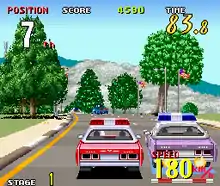Cisco Heat
Cisco Heat: All American Police Car Race[lower-alpha 1] is a 1990 racing arcade game developed and published by Jaleco. It is similar to games such as Chase H.Q. and Out Run, where players control a police squad car that must race against other computer-controlled players to make it to the end of each race in first place. Players can also take different routes to bypass certain portions of the game. Three different cabinet types were created, a standard upright, a sit-down, and a motion-based "deluxe" machine; both of these could be connected, or "linked", together to enable multiplayer.
| Cisco Heat | |
|---|---|
 North American flyer | |
| Developer(s) | Jaleco |
| Publisher(s) | Jaleco |
| Platform(s) | Amiga, Amstrad CPC, Arcade, Atari ST, Commodore 64, MS-DOS, ZX Spectrum |
| Release | |
| Genre(s) | Racing |
| Mode(s) | Single-player, multiplayer |
Cisco Heat was designed by many former employees of Sega, who had left the company to form BitBox, which developed Jaleco Rally: Big Run. After Jaleco absorbed the company, the team began work on a spiritual successor to Big Run, which became Cisco Heat. The game was ported to several home computers in European countries, including the Atari ST, Commodore 64 and Amiga, all of which were published by Image Works. The arcade version of Cisco Heat was praised for its gameplay, presentation and controls, with one finding it to be a drastic improvement over Jaleco's previous arcade games. Home computer ports were met with a more negative reception for their generally poor quality.
Gameplay

In Cisco Heat, players control a police squad car through San Francisco in an attempt to win the "National Championship Police Car Steeplechase" in first place. Gameplay is similar to Out Run and Chase H.Q.,[1] where players must race against computer-controlled vehicles to the end of each section, taking place in a different area of San Francisco.[2] Sections contain famous landmarks from the city, namely the Golden Gate Bridge, Alcatraz and tram cars, as well as several features such as steep dives, 90-degree turns and multiple selectable routes, which can allow players to bypass certain portions of the race and shortcut to another area.[1][2] Players can select from two different police cars, both being based on the Cadillac Brougham and Nissan 300ZX Z32 respectively. Up to four Cisco Heat cabinets can be connected, or "linked", together to enable multiplayer play.[3]
Development and release
Cisco Heat was developed and published by Jaleco, originally released in October 1990 in Japan.[4] It was released in North America in November 1990 and in Europe in early 1991.[5][3] Most of the development staff who worked on the game were former members of Sega, who left the company to form the short-lived developer Bit Box, which created Jaleco Rally: Big Run (1989).[6] After Jaleco absorbed the company in 1990, the development team became part of Jaleco and worked on a successor to Big Run, which later became Cisco Heat.[6] For this reason, Cisco Heat bears several similarities to Big Run, and was even marketed as a conversion kit for older Big Run arcade units.[6] The soundtrack was composed by Yasuhiko Takashiba.[7] Three different cabinet types were produced for the game, a standard upright machine, a sit-down, and a "deluxe" unit with minor motion capabilities.[2] In 1991, Cisco Heat was exhibited at the Amusement Trades Exhibition International expo in the United Kingdom.[3]
Cisco Heat was ported to several home computer platforms in 1991, all of which were developed by UK-based developers ICE Software and Moonstone Computing, and published by Image Works; these being the Atari ST, Commodore 64,[8] Amiga, MS-DOS, Amstrad CPC, ZX Spectrum, and several IBM-compatible PCs. The Amiga version in particular, designed by Stuart Campbell, was entirely reworked to accommodate for the computer's technical limitations, and in turn has little to do with the original arcade game. An Atari Jaguar version of Cisco Heat was announced in 1994, but was never released.[9]
Reception
| Publication | Score |
|---|---|
| Sinclair User | 94/100 (AC)[1] |
| Zzap!64 | 30% (C64)[8] |
| CU Amiga | 93% (AC)[10] |
| Commodore Format | 12% (C64)[11] |
| Amiga Format | 59% (AGA)[12] |
| Power Play | 35% (AGA)[13] |
The arcade version of Cisco Heat was met with a favorable reception from critics. Sinclair User compared it to Out Run and Chase H.Q. for their similar gameplay, saying that its impressive atmosphere, fast-paced action and generally well-made presentation made Cisco Heat "one hell of a driving game".[1] CU Amiga felt the same, and claimed that it was one of the better arcade games produced by Jaleco, and showed that they had the resources to produce a well-designed racer after Big Run.[10] They labeled it as a "stunner" for its presentation, gameplay and fast-paced action, alongside its responsive controls and colorful visuals.[10] The One called it "an urban Chase H.Q." for its similar gameplay and aesthetic, commending its multiplayer mode and cabinet linking system.[3]
The home computer ports were met with a far-less positive fanfare. Reviewing the Amiga version, Amiga Action criticized the controls for being sensitive, the scrolling for being jerky, and the graphics for being poorly-made.[12] They felt the game had a "rather amateurish" theme to it in regards to its presentation and overall quality, further criticizing it for being a generally unimpressive game.[12] German publication Power Play had a similar response, adding that the game lacked originality compared to other similar games for the system and for its 3D effects being of poor quality.[13] The Commodore 64 version received a record-low score of 12% by Commodore Format, who labeled it one of the worst games of 1991;[11] they lambasted nearly every aspect of the game, greatly disliking its presentation, jerky scrolling, bad framerate and large amount of glitches.[11] ZZap!64 shared many of the same criticisms, further disliking its lack of difficulty and bland music.[8] In light of their criticism, they liked the port's short load times, which were only at the beginning of the game.[8]
References
- Cook, John (December 1990). "Coin Ops: Cisco Heat - Jaleco". United Kingdom: EMAP. Sinclair User.
- "Cisco Heat - Videogame by Jaleco". Killer List of Videogames. The International Arcade Museum. Archived from the original on March 25, 2019. Retrieved February 21, 2020.
- Nesbitt, Brian (February 1991). "Coin-Operated Corkers!". The One. No. 29. emap Images. p. 20.
- "シスコヒート (アーケード) - ファミ通.com". Famitsu (in Japanese). Kadokawa Game Linkage. 2020. Archived from the original on June 27, 2018. Retrieved February 21, 2020.
- Akagi, Masumi (October 13, 2006). アーケードTVゲームリスト 国内•海外編 (1971-2005) (in Japanese) (1st ed.). Amusement News Agency. pp. 33, 121, 148. ISBN 978-4990251215.
- Kamiya, Hideki (June 15, 2015). "あれ…ではシスコヒート/デコ開発、ビッグラン/ビットボックス開発 というのは誤り…? RT @p7_hk : シスコヒートの開発はジャレコ内製ですよ。開発スタッフは元セガでスペハリなどを担当されてた方々です。ジャレコではBIGRUNやグランプリスターも同じスタッフです。". Twitter. Archived from the original on February 22, 2020. Retrieved February 22, 2020.
- Jaleco Archives. Japan: City Connection. November 30, 2016. ISBN 4408112038.
- "ZZap! Test! - Cisco Heat" (90). Newsfield Publications Ltd. ZZap!64. January 1992. p. 54. Archived from the original on February 22, 2020. Retrieved February 22, 2020.
- "Other Stuff". GameFan. Vol. 1 no. 10. Shinno Media. September 1993. pp. 166–167.
- Cooke, John (December 1990). "Arcades: Coin-Op Crisis - Cisco Heat" (10). United Kingdom: EMAP. CU Amiga. pp. 102–103. Retrieved February 22, 2020.
- Campbell, Colin (January 1992). "Powertest - Cisco Heat" (16). United Kingdom: Future plc. Commodore Format. p. 34. Retrieved February 22, 2020.
- Webb, Trenton (January 1992). "Screenplay - Cisco Heat" (30). Amiga Format. p. 129.
- "Cisco Heat". Power Play. January 1992. Archived from the original on February 22, 2020. Retrieved February 22, 2020.